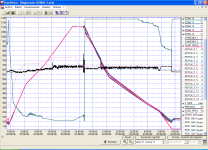geniusintraining
Lifetime Supporting Member + Moderator
The programmer had initially used PID. ("That's our standard.") We diddled around for half a day and couldn't get it tuned for reasonable response and stability at both high and low flows. The blower response to valve changes is very non-linear, but fast compared to the process- a couple of seconds
Cool, thats one of the reasons I put several variables on my trainer... you can control the fan speed, a manual damper on the top and also a electrical damper on the bottom, I found its was fairly easy to tune something with a single action, say heating a platen but once you introduce another variable it gets a lot harder fast, I have been lucky to be involved in several projects that you are trying to stabilize your process variable with a fluctuating control variable and that taught me a lot.
I had one system that was heating air (incinerating) via natural gas to 1450 deg and that would normally not be a big deal but the air that we were incinerating was ranging in temp from 100-600 deg and then it also had a LEL from 0-30 and it had a huge variable speed fan that was keeping the other system negative so your SCFM would change also... forgot the size of the fan but it was over 6ft tall, we ended up making two PID's depending how far away it was from the SP was depending what PID it used.... sounds like I could of used floating control back then
Thanks again





